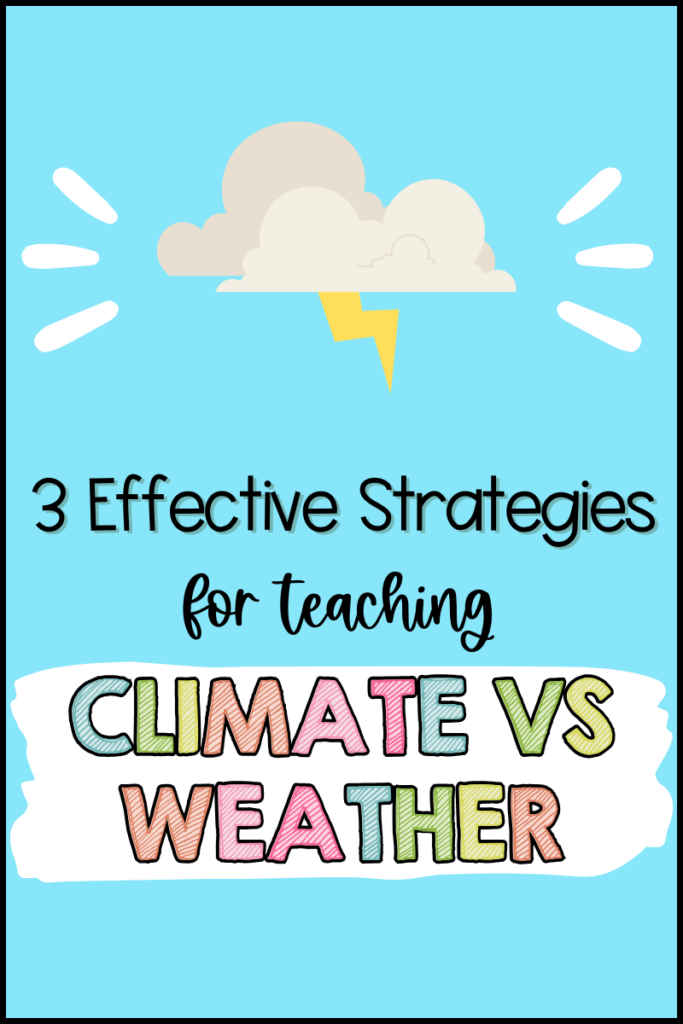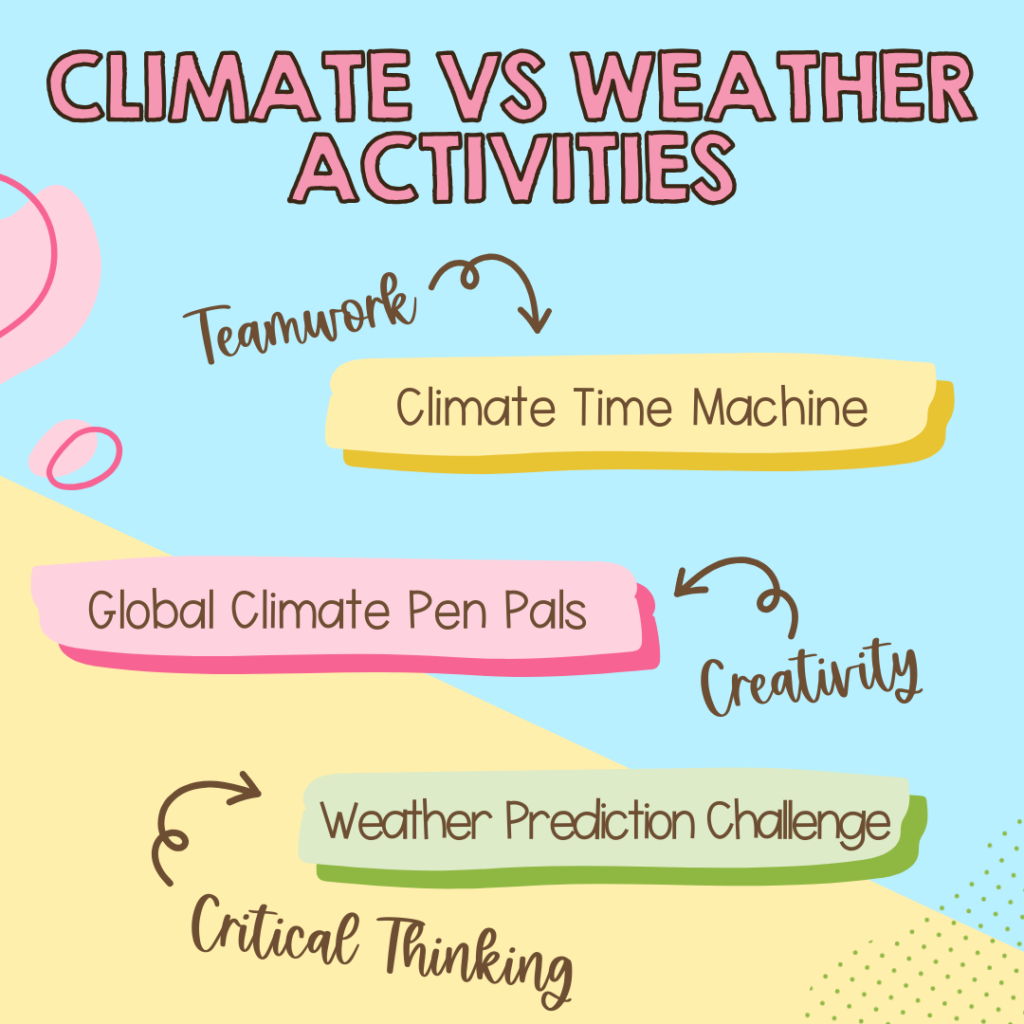Climate change has been trending upward, yet as I type this, my backyard (and driveway…) are covered in 18 inches of snow. I don’t know about you, but after Michigan’s recent snowfall, my Facebook feed has been nothing but a plethora of “Where is global warming now?” jokes. It’s clear to me that we need to do a better job highlighting the distinct differences of climate vs weather.
And thus, a blog post was born.
Of course, these strategies are aimed at upper elementary science students, but that’s okay; the next generation will have a better grasp on climate vs. weather! Climate and weather are certainly interconnected, but they have a plethora of differences, too. With the right strategies in place, your kiddos will grow to distinguish between the two.
Weather is one of my favorite science topics, and climate naturally follows. Weather is extremely versatile and can change in a heartbeat, while climate is (usually) more stable… But more on that later! First, let’s take a look at a few of the key differences of climate vs weather in order to iron out a few wrinkles. It’s best if we’re all on the same page here, right? 😉
Key Climate vs Weather Concepts
First things first: definitions! Climate is defined by the Oxford English Dictionary as “the weather conditions prevailing in an area in general or over a long period,” while weather is “the state of the atmosphere at a place and time as regards heat, dryness, sunshine, wind, rain, etc.” Your kiddos’ textbook definitions may be a bit simpler, but that’s the general gist of it! Obviously, climate and weather are related, yet are still distinct from one another.
Climate is more than just “weather over time,” however. Earth’s climate has a rich and varied history that I encourage you to explore with your students! In fact, depending on how deeply you plan to delve with your classroom, you may even choose to examine the differences in geological epochs, or time periods in Earth’s history that are marked by significant changes in climates, life forms, and geological conditions. Because Earth’s climate was so different, the weather of certain eras was wildly different, too!
It’s not just history that has the pleasure of different climates, either: there are plenty of climate zones scattered around the Earth that are categorized by their distinct climatic conditions. The Arctica climate is vastly different from the climate of temperate North America, even if Michigan doesn’t always feel too far off from the tundra!
It’s also important for students to explore environmental awareness. Both weather and climate can have significant impacts on the environment, especially when it comes to the role of humankind in climate change. In fact, it’s entirely possible students have already heard the phrase “global warming” before hitting your classroom–that’s how prevalent climate change is in today’s society.
Although this article is all about highlighting the differences of climate vs weather, students should also come to understand that these two concepts are not necessarily pitted against one another; in many ways, climate and weather work together to impact the world’s ecosystems. With that being said, let’s take a look at a few activities that really teach climate vs weather!
Climate vs Weather Activities
1. Climate Time Machine (with Weather Insights)
I love a good “time machine” activity! There’s a reason time machines are so prevalent in science fiction: it’s fun!
For this activity, your students will come to understand climate vs weather by exploring Earth’s climate history through different geological epochs and incorporating daily weather patterns appropriate for the time period. This activity will also illustrate how Earth’s climate and weather have evolved over millions of years. As an extension, you could even use past climate changes to show how rapidly our current climate situation is changing, and brainstorm ideas as to why these rapid changes are harmful.
But I’m getting ahead of myself! First, let’s take a look at the materials needed for this activity. You’ll want to collect informational passages or cards about each epoch for students to do their research… Aaaand that’s it! Easy, right? You can provide additional materials, such as a fan for wind or a spray bottle for rain if you really want to go crazy with the immersion, but that’s not necessary.
To begin the activity, start off with a class-wide discussion highlighting the differences of climate vs weather as well as introducing the idea (or reminding them) of a geological epoch. Then, explain how weather can vary within the broader climate of an epoch. Afterward, you’ll want to divide students into groups, where each group is responsible for a different geological epoch.
Groups will research their assigned epoch using research materials provided, focusing on both climate and typical weather patterns. Based on this research, groups should prepare presentations incorporating facts about the climate and examples of weather events from that epoch. If you’d like, you can encourage groups to write skits where they act out traveling through time in their time machines and arriving at their assigned epoch! This is also where you can provide extra props, such as paper confetti for snow during the Ice Age.
The goal of each group should be to inform their classmates about their epoch, taking care to highlight the differences of that era’s climate vs weather occurrences. Bonus points for using fans to create wind or other engaging props that’ll really sell the time travel aspect! It’s also a good idea to allow students to use multimedia resources, such as providing an icy background for the Ice Age or dinosaur images for the Jurassic Era. Students should also share how the climate and weather affect their daily lives in their epoch.
After each group has presented, engage the class in a discussion about what they learned regarding the differences in climate vs weather as well as the relationship the two concepts share. Discuss how climate “sets the stage” for the range of weather events experienced in an epoch!
As an extension, have your kiddos create a “weather diary” or a comic strip illustrating weather events in a specific epoch, showing their understanding of how weather fits into the broader climate context. You could even hang up their comic strips… Who doesn’t love a good hallway display?
2. Global Climate and Weather Pen Pals
There’s no time traveling involved with this activity, but that shouldn’t dampen any of the fun. This activity is set to enhance students’ understanding of the differences as well as similarities in the grand climate vs weather debate around the world. Here, they’ll communicate with peers in “different climate zones” and learn firsthand about various global climates and the daily weather experienced in these regions!
This activity doesn’t require too many materials, either. You’ll need a world map (or copies to distribute to each student), research materials students can use to gather information about different climates (technology integration, anyone?), and, of course, stationery for students to write their letters. No stamps necessary!

To start, assign a climate zone to each student, or let them choose their own! It’s okay if there’s overlap between students–just try to ensure their “pen pal” doesn’t share a climate zone that’s too similar. I would recommend looking at biomes around the world and basing your climate zones off of those.
Once students have their assigned zones, allow them time to research the climate and weather of their region. What are the differences of climate vs weather in that area? How does the weather affect their daily lives? Is the climate comfortable overall, or is it rather tempestuous? There are plenty of questions to asked and be answered between pen pals!
When students feel comfortable enough to answer questions about their climate zones, encourage them to partner up with someone who “lives” in a different climate zone and write letters to one another. They should share information about their own local climate vs weather experiences as well as inquire about their pen pal’s situation.
As a class, brainstorm what students noticed about climate zones using the world map. Are climates on one continent mostly the same? What about the weather? There are dozens of questions that can be asked and answered regarding climate zones, and you can take this opportunity to think-pair-share for extra (beneficial) socialization.
Ultimately, ensure that you’re encouraging students to reflect on what they’ve learned about the diversity of climate vs weather on a global scale. Discuss the importance of understanding global climates, especially in the context of environmental awareness and climate change. Students are our future, after all!
3. Weather Prediction Challenge
Let’s be real: it’s hard to predict the weather. Just today, I watched next week’s forecasted temperatures drop several times! No shade to meteorologists, though–they’re doing what they can, and your students are about to find out how tough their jobs are.
This activity aims to engage upper elementary students in understanding and predicting weather using real-time data and technology integration, as well as exploring the concept of climate, helping them distinguish between short-term weather forecasts and long-term climate patterns.
For this activity, you’ll need access to current weather data, such as ol’ reliable weather.com. Whichever resource you choose, make sure it uses real-time data! This activity works best if each student has access to their own current weather data, via laptops or tablets, that way you don’t need to look up 25 different locations. In addition, you’ll need journals for students to record data as well as a world map to discuss and locate different climate zones.
To start, begin with the usual discussion differentiating weather vs climate; i.e., daily atmospheric conditions vs long-term patterns in a given region. You may also want to go over basic meteorological concepts, like humidity, temperature, precipitation, and so on, though it’s likely your science students are already familiar with these concepts. If not, check out my Weather Detectives Vocabulary Game!
After the introductory discussion, assign students a climate zone, or allow them to choose. It may be best to have students choose a country, then assign them the capital of that country to make things simple. Then, students will access real-time weather data for their assigned local area and record specific concepts over the course of a week. Some ideas to track are temperature, wind speed, chance of precipitation, humidity, and so on–the idea is to grab all the weather data you can!
Once students have collected enough data, guide them through analyzing it in order to make weather predictions for the upcoming week. Encourage them to consider variables such as seasonal trends and historical weather patterns, too. If they’re investigating an area with monsoons every summer, that’s something they should take into account!
When predictions have been made, reconvene the following week to check for forecasting accuracy. It’s totally fine if their predictions were inaccurate; most weather forecasts are, am I right? 😉 Encourage students to present their findings, the reasoning behind their predictions, and why they think the weather differed (or not) from their forecast.
After comparing, lead a classroom discussion on how the local climate influences weather patterns. Use a world map to identify different climate zones and brainstorm how climate affects weather predictions in various areas of the world. Using this information, what seem to be the differences in climate vs weather? How are they similar? How do they affect one another?
Climate vs weather is a topic that isn’t always clearly understood. Thankfully, there are plenty of activities and resources that help to clarify the differences as well as emphasize their relation. Climate and weather go hand-in-hand, certainly, but are still two separate concepts at the end of the day. If you’re looking for resources that further illustrate this point, check out my Severe Weather STEM activity.
Exploring the idea of climate vs weather in upper elementary helps to create environmentally-aware individuals who are more likely to consider the impacts of our actions on Earth’s climate as well as identify weather patterns that result from climate change. And, according to my Facebook feed… That’s something we could definitely use more of!
What activities or resources do you like to use when exploring climate vs weather? Let us know in the comments below! I can’t wait to hear them.

















